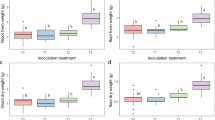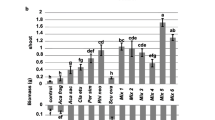Abstract
Arbuscular mycorrhizal (AM) fungi are mutualistic symbionts imparting a number of benefits to plants and are being advocated for being potential biofertilizer in the agriculture and forestry sectors. Superior AM fungi for forestry tree species (Acacia nilotica var. cupressiformis, Albizzia lebbeck and Eucalyptus tereticornis) and horticultural plant species (Capsicum annum, Allium cepa and Fragaria ananassa) were evaluated in a completely randomized design microcosm trial involving AM species of native and exotic origin. Out of ten AM fungal species used with forest species, G. intraradices (AM-1004) and mixed indigenous AM fungi (AM-1209) were found to give the highest P uptake in shoots, whereas in horticultural plants AM-1004 and AM-1207 (commercial inoculum, Mycorise) followed by mixed indigenous AM fungi (AM-1209) gave the highest P uptake in shoots. The shoot dry weight in these superior AM-mediated plants also indicated greater response and were highly correlated with P uptake (r = 0.53–0.88) and to a lesser extent with root colonization (r = 0.41–0.81). P uptake in the early growth stage (6–8 weeks) of AM-inoculated plants can be used as an indicator to evaluate superior AM fungi for growth promotion of forestry and horticultural plant species.


Similar content being viewed by others
References
Sharma MP, Adholeya A (2004) Influence of arbuscular mycorrhizal fungi and phosphorus fertilization on the post-vitro growth and yield of micropropagated strawberry in an Alfisol. Can J Bot 82:322–328
Sharma MP, Bhatia NP, Adholeya A (2001) Mycorrhizal dependency and growth responses of Acacia nilotica and Albizzia lebbeck to inoculation by indigenous AM fungi as influenced by available soil P levels in a semi-arid Alfisol wasteland. New Forests 21:89–104
Sharma MP, Reddy UG, Adholeya A (2011) Response of arbuscular mycorrhizal fungi on wheat (Triticum aestivum L.) grown conventionally and on beds in a sandy loam soil. Indian J Microbiol 51:384–389
Bagyaraj DJ, Reddy MS, Nalini PA (1989) Selection of an efficient inoculant VA mycorrhizal fungus for Leucaena. Forest Ecol Manag 27:81–85
Sieverding E (1991) Vesicular-arbuscular mycorrhiza management in tropical agrosystems. German Agency for Technical Cooperation (GTZ), Eschborn
Lovato PE, Schuepp H, Giganinazzi S (1995) Application of arbuscular mycorrhizal fungi in orchard and ornamental plants. In: Varma A, Hock B (eds) Mycorrhiza structure, function, molecular biology and biotechnology. Springer, Heidelberg, pp 521–559
Walker C (1992) Systematics and taxonomy of the arbuscular endomycorrhizal fungi (Glomales): a possible way forward. Agronomie 12:887–897
Gill AAS, Bhadoria PBS, Sadana US (2012) Effect of mycorrhizal infection on phosphorus efficiency of maize (Zea mays L.) cultivars. Proc Natl Acad Sci India, Sect B. doi:10.1007/s40011-012-0114-1
Sieverding E, Toro S (1988) Influence of soil water regimes on VA mycorrhiza V. Performance of different AM fungi species with cassava. J Agron Crop Sci 161:322–332
Olsen SR, Cole CV, Watanabe FS, Dean LA (1954) Estimation of available phosphorus in soils by extraction with sodium bicarbonate. Circular No. 939. US Department of Agriculture, Washington, DC
Datta NP, Khera MS, Saini TR (1962) A rapid calorimetric procedure for the determination of the organic carbon in soils. J Indian Soc Soil Sci 10:67–74
Sharma MP, Gaur A, Bhatia NP, Adholeya A (1996) Mycorrhizal dependency of Acacia nilotica var. cupriciformis to indigenous vesicular arbuscular mycorrhizal consortium in a wasteland soil. Mycorrhiza 6:441–446
Hoagland DR, Arnon DI (1938) The water culture method of growing plants without soil. Circular No. 347.California Agricultural Experiment Station, Berkeley
Ross JP, Harper JP (1970) Effect of Endogone mycorrhiza on soybean yields. Phytopathology 60:1552–1556
Kitson R, Mellon MG (1944) Colorimetric determination of phosphorus as molybdivanado phosphoric acid. Ind Eng Chem Anal Ed 16:379–383
Biermann BJ, Linderman RG (1983) Use of vesicular arbuscular mycorrhizal roots, intraradical vesicles and extra radical vesicles as inoculum. New Phytol 95:97–106
Phillips SJM, Hayman DS (1970) Improved procedures for clearing roots and staining parasitic and vesicular-arbuscular mycorrhizal fungi for rapid assessment of infection. Trans Br Mycol Soc 55:158–160
SAS Institute Inc. (1991) SAS/STAT user’s guide, release 6.03. SAS Institute Inc., Cary
Gianinazzi S, Gianinazzi-Pearson V, Trouvelot A (1989) Potentialities and procedures for the use of endomycorrhizas with special emphasis on high value crops. In: Whipps JM, Lumsden B (eds) Biotechnology of fungi for improving plant growth. Cambridge University Press, Cambridge, pp 41–54
McArthur DAJ, Knowles NR (1993) Influence of vesicular-arbuscular mycorrhizal fungi on the response of potato to phosphorus deficiency. Plant Physiol 101:147–160
Thaper HS, Vijayan AK, Uniyal K (1992) VAM association and root colonization in some important tree species. Ind Forest 118:207–217
Adjoud D, Plenchette C, Halli-Hargas R, Lapeyrie F (1996) Response of 11 Eucalyptus species to inoculation with three arbuscular mycorrhizal fungi. Mycorrhiza 6:129–135
Clark RB, Zeto SK, Zobel RW (1999) Arbuscular mycorrhizal fungal isolate effectiveness on growth and root colonization of Panicum virgatum in acidic soil. Soil Biol Biochem 31:1757–1763
Gaur A, Adholeya A, Mukerji KG (1998) A comparison of AM fungi inoculants using Capsicum and Polianthes in marginal soil amended with organic matter. Mycorrhiza 7:307–312
Jolicoeur M, Williams RD, Chavarie C, Fortin JA, Archambault J (1999) Production of Glomus intraradices propagules, an arbuscular mycorrhizal fungus, in an airlift bioreactor. Biotechnol Bioeng 63:224–232
Acknowledgments
The present study was supported by funding from the Department of Biotechnology, Government of India. The authors wish to thank Director General, TERI for providing the infrastructural facilities. Thanks are also due to Director, Directorate of Soybean Research (DSR-ICAR), India for providing necessary facilities to the senior author on the data analysis and manuscript preparation. The technical assistance from Mr. Kanchan Kumar in conducting the experiment is duly acknowledged.
Author information
Authors and Affiliations
Corresponding author
Rights and permissions
About this article
Cite this article
Sharma, M.P., Adholeya, A. Parameters for Selecting Efficient Arbuscular Mycorrhizal Fungi for Plants Under Microcosm Conditions. Proc. Natl. Acad. Sci., India, Sect. B Biol. Sci. 85, 77–83 (2015). https://doi.org/10.1007/s40011-013-0263-x
Received:
Revised:
Accepted:
Published:
Issue Date:
DOI: https://doi.org/10.1007/s40011-013-0263-x




